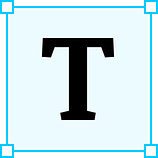Web accessibility for people with Dyslexia: emerging research
 The book Dyslexia and Accessibility in the Modern Era explores problems that people with dyslexia face while navigating the internet and proposes solutions to help. The policymakers and web content creators can learn what changes to their content will make it more accessible helping us to build a more inclusive world. The book is available also as on a per chapter basis, which is why I will talk about specific chapters and their content in the end of the article.
The book Dyslexia and Accessibility in the Modern Era explores problems that people with dyslexia face while navigating the internet and proposes solutions to help. The policymakers and web content creators can learn what changes to their content will make it more accessible helping us to build a more inclusive world. The book is available also as on a per chapter basis, which is why I will talk about specific chapters and their content in the end of the article.
The written word, including its digital forms, is an important means of communication among people. “The technological revolution,” whose origins date back to the last decades of the 20th century, has impacted life both in a good and bad way. On the one hand, technology has made learning much easier, but on the other hand, it has increased the demands on mental processes involved in processing written information. It endangers the quality of life of people who have reading difficulties and who are not completely functionally literate.
The research of dyslexia has received considerable attention on the national and international levels. The authors in this book present the starting points of current research, problems the research faces, and potential future direction. To put the research into the complete context, the authors also present the current legislation surrounding people with dyslexia. In the more practical part of the book, the authors present the problems that individuals with dyslexia face in everyday life, along with the tools that simplify the solutions to these problems.
This book is primarily focused on the teachers who work and are in contact with people with dyslexia. The book presents dyslexia in the context of lifelong learning, simplifies the understanding of the problems that people with dyslexia face, and allows them to realize that this is a lifelong situation for them. The book is also suitable for parents, partners, and friends of the people with dyslexia. It simplifies the understanding of challenges that people with dyslexia face, points to the effective helping strategies, aspects that make their life more complex, and available help resources. The authors will introduce them to some of the tools that can simplify the life of people with dyslexia. The last group is the creators preparing the materials for people with dyslexia. That gives them further information on how they should prepare the materials from a typographical point of view, as well as design tools that allow them to verify that their applications are accessible to people with dyslexia.
Book structure
The book is separated into three basic sections. The first one contains chapters relating to the theoretical and social background of the research project. It introduces the readers into the broader context of the phenomenon of dyslexia, literacy, and their impact on the quality of life and inclusion in society. It points to the possibilities and framework of support, strengthening, and guiding people with dyslexia/reading problems while learning and searching for ways to change their reading skills and life situation.
The first chapter maps out the current situation of dyslexia research from the perspective of the International Dyslexia Association and the World Health Organization, including the new approaches to specific learning disorders in DSM_5. It describes the interdisciplinary trends in the approach to specific developmental learning disorders. In the context of learning disability and academic performance, there are a limited number of studies that deal with multiple resources.
To put the research in context, the authors also present the topic of the web accessibility for people with dyslexia and its legislative treatment by the key international players.
The second chapter is devoted to the IT technologies permeating the life of the whole society in education, professional, and personal life. Since they increase demands on reading competencies, difficulties with reading are a source of barriers to inclusion. Therefore, strengthening the reading skills and expanding the options to lifelong learning are the ways to overcome barriers. We provide approaches to dyslexia and reading skills in a brief overview in chapter three. The support and intervention of reading skills reflect the current knowledge in research. Understanding the processes of the different stages of reading skills development is particularly important to prevent the side effects of the failure experience for both children and adolescents, and also to support strategies for enhancing reading competencies.
Early recognition of barriers in reading processes and subsequent intervention is a prerequisite for successful management of school work and learning. The variability and complexity of reading difficulties are illustrated by the life stories of individuals with dyslexia published on the Literacy portal in the Community Zone. Information on the necessity of early intervention and the system of care for individuals with dyslexia in the Czech Republic concludes this chapter.
The fourth chapter analyses the terms like an alphabet, literacy, illiteracy, and their development into the present. We are getting introduced to the term “functional literacy.” Reading literacy is viewed here in terms of individual levels and ages. The chapter contains information about the research focused on the age: PIRLS carried out by IEA (International Association for the Evaluation of Educational Achievement), and research PISA, which has been organized by The Organisation for Economic Co-operation and Development. Both types of research have been focused on literacy, and their authors also have named them differently for several ages. There are plenty of different approaches for making reading more attractive , and we provide some of them as inspiration. One of the parts is devoted to the development of reading literacy in individuals with dyslexia.
The goal of the fifth chapter is to describe the current state of the field with respect to the available tools for education with the usage of modern technologies and their potential for the usage by people with dyslexia. The phenomenon MOOC (Massive Online Open Courses) has had a major impact on this field in recent years. These platforms were at the time of writing the book the most important providers of education via the internet. Among the best known are the Coursera, Udacity, edX, and Khan Academy. Apart from the key platforms, we will also mention smaller and more specialized tools available through the internet.
The second section includes chapters related to research and development of the Literacy portal and introduces readers to chosen strategies and procedures. The sixth chapter is about the Literacy Portal, which offers the space for informal learning. It’s summary and framework go with the needs of the users. People with dyslexia were involved in the process of concept development, which is reflected in the usefulness of the portal. It offers to strengthen the resilience and coping strategies with the focus on the key skills of the 21st century, which we will also mention here. At the time of the initial development of the portal, this was an unexplored topic. Part of this chapter is to evaluate the suitability of the site as a way to activate and develop one’s reading skills.
The seventh chapter focuses on the goal of the project, which is to create a modern online portal for training of reading techniques and understanding, for effectively using the internet environment in everyday life, and for creating social communities of the users. The portal was created by the effort of following the rules of Human Centers Design. During its creation, mixed research strategies with triangulation of methods were used, ranging from the analysis of documents and website content, through focus groups, testing, interviews to questionnaires. The strategy for the work with focus groups showed effective and ineffective approaches to the adults and adolescents with dyslexia in the context of research activities.
The following eighth chapter introduces the progress of the portal Literacy website creation.Together readers and authors will read the gradual development of an interview based on the principle of active listening to the semi-structured interview, which was completed by the survey focused on problems with reading and the internet. They will find out what the method of card-sorting was, how it went on, what its main goal was, and how it affected the creation of the portal. The critical part is also the orientation through the whole webpages. That is why the procedure for selecting a menu was described, followed by the selection of icons and monitoring the ability of individuals with dyslexia to navigate the web using the button and vertical menus. The results and findings were reflected in the demands of an administrative environment adapted to individuals with dyslexia. One of the goals of the authors was to verify the methods for the creation of the portal with the maximal reflection of feedback from users who were the target audience.
The ninth and the tenth chapter are about the Literacy portal. Its tools and materials support the knowledge, understanding, and using the internet as well as the ICT tools for improving its effective use in everyday life. The Literacy portal has offered users a personalized learning path for research. It has made it possible to test one’s skills and competencies critical for reading. The outcome of the testing was the user’s cognitive profile and the personalized learning offer built on it. In this chapter, we will introduce readers to parameters the cognitive profile consisted of and what kinds of training sessions were part of the portal at the time of its creation. Readers will learn the results of e-learning content validation in terms of benefits, clarity, and time spent at the time of validation of the portal.
The eleventh chapter is the summary of the reflections of the respondents, the users of the portal. It is based on their feedback, comments, and outputs of the evaluation questionnaire. It represents the interpretation of their attitudes and views on areas/topics, such as their importance and necessity. We then proceeded from the analysis of respondents’ statements and evaluation of the portal by the respondents. We will also present the recommendations we have made based on this analysis.
The third part focuses on creating methods for the evaluation of web applications concerning the group of individuals with dyslexia. The creation of the methods for the evaluation of web applications based on their accessibility to people with dyslexia is the content of Chapter 12. The methods describe key characteristics of the applications for people with dyslexia. A rating of one hundred points simplifies the understanding of how far the creators are from the optimum accessibility to people with dyslexia. The authors also mention the available assistive tools that can simplify the lives of users with dyslexia on the internet.
